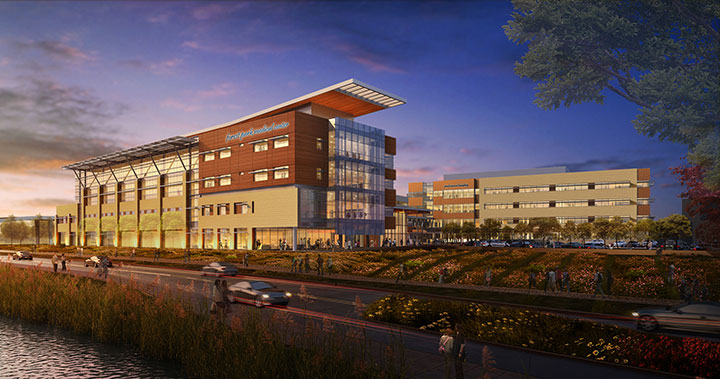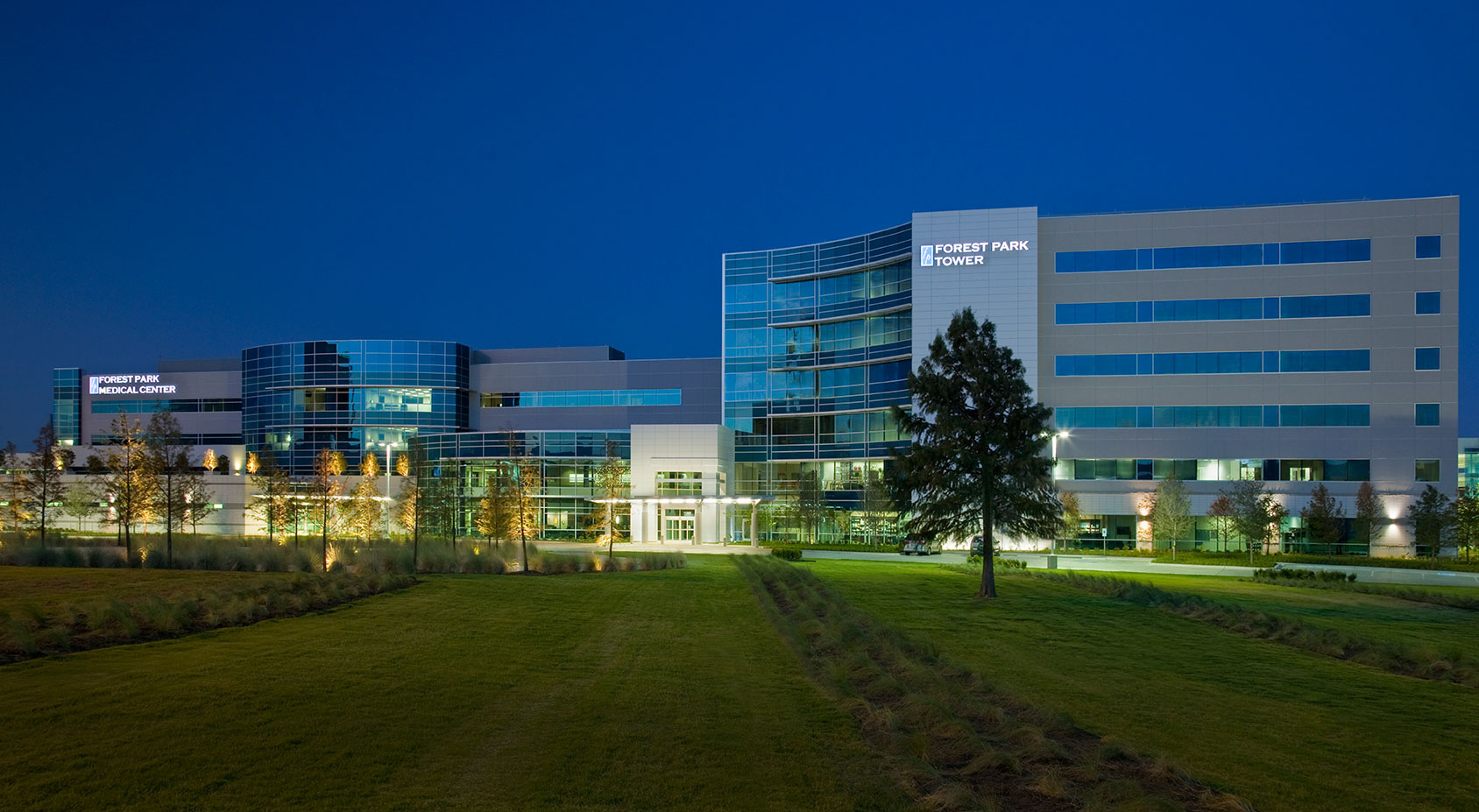Walking through the five-year-old Forest Park Medical Center in Dallas, you couldn’t be blamed for thinking you’re in a W Hotel instead of a hospital. A dramatic staircase sweeps down from the second floor into the lobby, where plush sofas and chairs have been arranged around big-screen TVs. The medical center boasts a Starbucks coffee bar, a rooftop garden complete with native grasses, and an upscale dining facility offering fare like fresh salad and cooked-to-order salmon. A number of special private “suites” have been set aside for the families of patients staying overnight.
Forest Park doesn’t even smell like a hospital. That’s because a customized scent called “Clean Sheets” is pumped continuously through the HVAC system, just like at a fancy Ritz-Carlton. Says Carolyn Goodrich, who was waiting in the Forest Park lobby for a relative to be discharged one recent afternoon: “We didn’t know how pleasant it was until we got here.”
All these luxury touches, Forest Park says, are the result of careful planning. “We’re thinking of the patient experience. It’s all about the patient,” says Dr. J. Robert Wyatt, Forest Park’s chief medical officer and one of its managing directors. “When you walk into a hospital for surgery, there’s a lot of anxiety. So we do everything we can to defuse the anxiety.”
Who could argue with an approach to medical care like that? Plenty of people, it turns out. The company that owns Forest Park, which also has medical centers in Frisco and Southlake plus three more under construction in Texas, operates what are called physician-owned hospitals. Unlike “general” nonprofit or public hospitals, such as Methodist Health System or Parkland Health & Hospital System, say, physician-owned hospitals are owned and run at least partly by doctors. And critics, including the powerful American Hospital Association (AHA), contend that physician ownership opens the door to conflicts of interest, even as it “cherry-picks,” or steals away, the most profitable patients. That erodes the ability of general hospitals to be successful, they say. Physician-owned hospitals strongly disagree, arguing that they offer a higher quality of care, increased patient satisfaction, better outcomes, and often lower costs.
Forest Park isn’t the only doctor-owned hospital company in North Texas. But because it has expanded so rapidly, it can be seen as something of a bellwether for physician-owned hospitals in Texas.
Since ours is one of about 15 states that doesn’t require a state-issued “certificate of need” to justify building new hospitals, Texas has become ground zero for these controversial facilities. There are an estimated 5,000 “community” (nonprofit, for-profit, or state and local government) hospitals in the United States, but only about 230 physician-owned hospitals—as many as 75 of them in Texas. Says Ellen Pryga, director of policy for the AHA: “Texas is awash in them.”Who could argue with an approach to medical care like Forest Park’s? Plenty of people, it turns out.
In many ways, Forest Park’s story illustrates the David-and-Goliath-like debate that’s occurring between the mainstream healthcare establishment and “disrupters”—like Forest Park—that are shaking up the status quo. And, it sort of makes you scratch your head and wonder: What in the world is the establishment so worried about?

STATUS QUO
The idea for Forest Park originated with Dr. Richard Touissant, an anesthesiologist, and Dr. Wade Barker, a bariatric surgeon, Wyatt recalls. In 2007, the two Dallas doctors had grown increasingly frustrated by the inefficiencies they experienced practicing at other medical facilities. The “real vision was to build a hospital that we thought could do it better,” says Wyatt, an ear, nose, and throat specialist who would join the two founding physicians, along with Dr. David Genecov, a plastic surgeon, a little later.
Soon, Touissant and Barker began making plans for a new kind of hospital that could handle several times the customary volume of patients, using state-of-the-art equipment and higher nursing ratios in an attractively modern, concierge-like setting. To execute this vision the doctors turned to Derrick Evers, a young real estate developer with The Staubach Co. The physicians persuaded Evers to help them form their own development company, calling it the Neal Richards Group, and hired Evers as CEO. Then, though, the economy tanked as the Great Recession kicked in. The fledgling company was forced to raise its own equity—from a group of high-net-worth individuals including physicians—and to arrange for its own debt financing. The doctors also formed a hospital operations group, called Vibrant Healthcare LLC, to manage the new venture.
The first phase of the doctors’ Forest Park Medical Center Dallas opened in March 2009 and, within just three months, the facility was operating at full capacity. After an expansion two years later, the 191,000-square-foot hospital off North Central Expressway now boasts 84 private inpatient rooms, 22 operating suites, 12 intensive care units, an imaging center, and an emergency room. Today there are about 90 physician-owners at Forest Park Dallas, as well as 450 physicians with medical privileges there.
Following the success of the first hospital, Forest Park facilities went up in Frisco in June of 2012 and in Southlake a year later. The 128,000-square-foot Frisco hospital has 30 private inpatient rooms and 12 operating suites. Southlake, which totals, 142,000 square feet, has 54 private inpatient rooms and a dozen operating suites. Both facilities have imaging centers and ERs as well.
Each of the Forest Park hospitals costs between $85 million and $100 million and has its own CEO, chief of staff, and physician-investment group. Each is at least 70 percent owned by local doctors, who put a maximum of $250,000 apiece into the operation. But more than half the surgeries at the Dallas facility, for example, are performed by physicians who are not investors.
Each of the facilities also focuses on a different surgical specialty. In Southlake, for instance, the biggest specialty by percentage is orthopedic surgery. Gynecology dominates in Frisco, while bariatric procedures for weight loss account for most of the work done in Dallas. Since its founding, Forest Park has performed nearly 12,000 bariatric procedures in all—more than just about any provider in Texas, the company claims.

The Forest Park hospitals have been designed with two groups of “clients” in mind: the patients and the medical staff. “We worked closely with the nurses and asked, ‘How many steps do you take? What works for you?’ ” Evers recalls. “We counted the number of steps between their stations and determined that a ‘racetrack’ design” for the caregiving areas would be most efficient. As a result of more efficient design, there’s less “dead time” between surgeries, the Forest Park owners contend, allowing their doctors to do 12 operations, say, where just three or four might be done in a more traditional setting.
The hospitals also were constructed to be pleasing for the patients. Each has convenient parking, water features, high ceilings, lots of art on the walls, and natural building materials like wood and granite. Forest Park admits to cribbing ideas from Las Vegas casinos and five-star hotels—and even from the Walt Disney Co. “At Disney World,” says Evers, “they don’t just point a person to a place; they escort you there. It’s that high-touch service,” he adds, that Forest Park aims to emulate.
Besides buying into the ownership of each hospital, Forest Park’s physician-owners may also pony up for ownership on the real estate side. These funding formulas—and the existing medical centers—have been so successful, three more Forest Park hospitals are under construction now in Fort Worth, San Antonio, and Austin. The 150,000-square-foot Cowtown and San Antonio facilities are slated to open this year, while a 145,000-square-foot hospital in the Texas capital is scheduled to start accepting patients in the first part of 2015.
Such robust expansion hasn’t gone unnoticed by the national investment community. Last October, Irvine, California-based Sabra Health Care REIT Inc. acquired Forest Park’s Frisco hospital for $119.8 million, and agreed to provide its Fort Worth facility with a construction loan of up to $66.8 million. The real estate investment trust also wrote a $110 million mortgage loan for Forest Park Dallas, acquiring an option in the process to purchase the hospital for up to $168 million. With the Frisco purchase, Sabra said it assumed an existing, long-term, triple-net lease with the facility’s operating partnership, an arrangement that will result in annual lease revenue to the REIT of about $13.3 million, and an initial “yield-on-cash” rent of 8.75 percent.
In a statement at the time, Sabra explained the deals by citing Forest Park’s clean and efficient technology, its “unsurpassed” surgical care, and its five-star hotel-like setting. “The model is consistent with what we see happening with healthcare reform,” the statement added.
Sabra Chairman and CEO Richard Matros, whose company invests in healthcare real estate

The acquisition deal with Sabra for the Frisco hospital was important, Evers says. “We wanted to show that there is an exit for these types of endeavors. Up until then, we’d had a long line of detractors,” he says. “They said we couldn’t get the doctors, that we couldn’t get financing, that we couldn’t monetize our assets, that we’d never open our doors. So, this was the last stop to prove that we could do it. It was a final stamp of approval, and it created tremendous buzz.”
‘ECO-BALANCE’
To say that ventures like Forest Park have “detractors” might be an understatement. For years, mainstream healthcare providers have fought fiercely to curb the spread of doctor-owned hospitals like Forest Park. Among other things, they’ve argued that physicians, motivated by greed, would make needless “self-referrals” to their own facilities, leading to unnecessary medical services and procedures and to higher healthcare costs.
In the 1980s, Rep. Pete Stark, D-California, was able to pass a law (referred to as the Stark Law) barring physicians from referring their Medicare and Medicaid patients to facilities in which they had a financial interest. Congress later modified this restriction somewhat, deciding that doctors could be able to refer patients to hospitals they owned or invested in, so long as they satisfied certain broad “exceptions” to the Stark Law.
While Rep. Stark tried to limit those exceptions in 2009, passage of the Patient Protection and Affordable Care Act the following year gave opponents of doctor-owned hospitals the big victory they long had sought. The ACA, popularly known as Obamacare, effectively eliminates the Stark Law exceptions and imposes tough new restrictions on physician-owned hospitals. Among other provisions, Obamacare put a permanent moratorium on the construction or expansion of new physician-owned hospitals within the Medicaid program, limited the expansion of existing doctor-owned facilities, and prohibited physicians from increasing their percentage of ownership in these hospitals.
An organization representing doctor-owned hospitals called Physician Hospitals of America (PHA), together with Tyler-based Texas Spine and Joint Hospital, fought back. They sued then-U.S. Health and Human Services Secretary Kathleen Sebelius over the restrictions, but the 5th Circuit Court of Appeals threw out the suit in 2012.
According to Pryga, the AHA policy director, the issue is simple: physician-owned hospitals are detrimental to the existing healthcare system. By using their physician-owners to steer patients with “easier,” highly lucrative health situations into their hospitals, Pryga says, doctor-owned facilities avoid treating low-income populations, increase utilization rates, and drive up health insurance costs. In doing so, she says, physician-owned hospitals degrade the financial health of general hospitals and lead to cutbacks in services. “They upset the eco-balance within the hospital environment,” she says.
The CEOs of two of Dallas-Fort Worth’s largest nonprofit hospital systems agree with some of Pryga’s argument. Physician-owned hospitals like Forest Park that don’t see patients on Medicare and Medicaid put a greater burden on nonprofit hospitals, which are required to serve all comers, they say. “The reimbursements, particularly in the Medicaid population, do not cover our costs,” says Joel Allison, chief executive of Baylor Scott & White Health. “So that just means safety-net hospitals are more strained in meeting the needs of our communities.”
As a result, adds Doug Hawthorne, CEO of Texas Health Resources, there’s no longer a “level playing field” among providers: “We feel accountable for all people, regardless of their ability to pay. So the issue is clearly one of being accountable to the community—or being accountable to [private] investors.”
Supporters of physician-owned hospitals say this argument is unfair, though, since it was the medical establishment itself—with help from lawmakers and President Barack Obama—that legally barred them from accepting the government-sponsored health insurance programs in the first place. They would seem to have a point. Leslie Fossey, media coordinator for the PHA, says the group wouldn’t have sued the government if its members hadn’t wanted to treat Medicare/Medicaid patients. In reality, Congress and the medical establishment believed the 2010 law would “cut us off at the knees,” she says.
Forest Park, for its part, says the charity-case argument is a red herring. Its business model has never included Medicare and Medicaid patients; after applying for and receiving Medicare certification, the company abandoned that direction after foreseeing, correctly, that Obamacare would ban such patients from facilities like theirs. However, Wyatt says, in addition to accepting private insurance, “we do see people that have no insurance and pay with cash. And they [THR and Baylor] have [doctor-owned] hospitals in their systems that are just like ours.” The bottom line, he says, is that Congress “passed a law that they hoped would wipe out” physician-owned hospitals like Forest Park.
DUELING STUDIES
To make their cases for or against such facilities, both sides have marshaled their share of authoritative-sounding studies. For example, the AHA circulates 2007 and 2008 reports indicating that physician self-referral results in higher utilization, driving up health insurance costs. The PHA says that’s not true, citing multiple studies—including from sources like the Centers for Medicare and Medicaid Services—showing there’s no evidence to suggest that physician-owned hospitals perform unnecessary procedures.
Similarly, the PHA cites quality measurements under the federal government’s new Value Based Purchasing Program, which rewards hospitals providing low-cost, high-quality care. Although just 197 doctor-owned hospitals participated in the program out of about 3,400 hospitals nationwide, nine of the Top 10 and 48 of the Top 100 performing facilities in the fiscal year beginning in October 2012 were physician-owned. The AHA retorts that one study “found no evidence that physician-owned specialty hospitals are more efficient”—or more cost-effective—“than the full-service hospitals with whom they compete.”
Still other PHA data shows doctor-owned hospitals spending 5.5 percent of their total revenue on “community benefits”—taxes paid, charitable care, etc.—as opposed to just .87 percent for general hospitals. (The general hospital figure is likely higher in Texas, which requires nonprofit hospitals to allocate a percentage of their gross revenue to uncompensated care.) Indeed, the PHA says, doctor-owned hospitals pay a significant amount of taxes,

Proponents like Matros of the Sabra REIT say opposition to doctor-owned hospitals is “all about sour grapes. Everybody’s going to have to change their model,” Matros says. “Anytime you have new competition for providers, in whatever sector, you see the existing providers tending to bitch about it.” Adds Fossey of the PHA: “If you can’t fight the competition, there are other ways to fight: change the law, make sure the [upstart players] can’t provide services to the community. The AHA is enormous. They’re so hard to fight. I have one lobbyist to their 1,000. They have millions of dollars more to spend than the little guy does. But we are the little engine that could.”
If Forest Park also is a “little engine” that could, it’s hoping to become a much bigger one down the road. Wyatt says the company, which employs 1,000 people, already is considering a number of expansion sites outside Texas. Among the states under consideration: Arizona, Arkansas, Colorado, Kansas, Louisiana, Nebraska, New Mexico, and Utah. The common denominator is that, like Texas, those states don’t require a state-issued certificate of need for new hospitals, relying for growth instead on the demands of the marketplace.
One key to its future, Forest Park says, will be finding doctor-partners in these states who are willing to try something new and innovative—despite the establishment’s opposition. “Did we catch lightning in a bottle?” Evers says. “Or can we take this show on the road?” Those are still open questions, but it might be smart to respect the company’s prescription for success.






